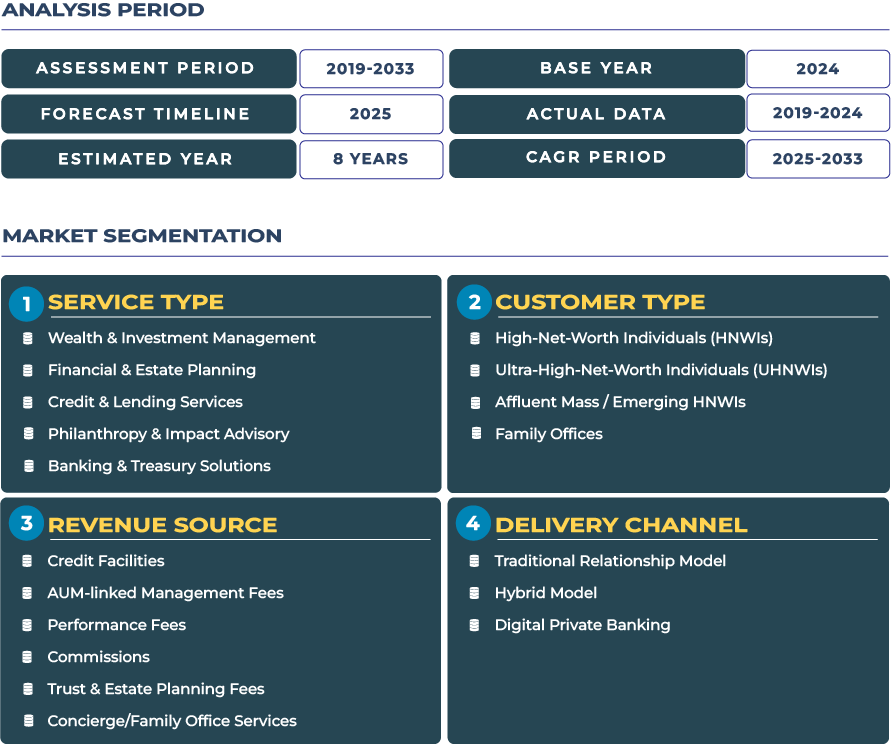Sovereign-Wealth Innovation and Global Expansion: Charting the Future of Qatar’s Private Banking Market
In Qatar, the private banking ecosystem is increasingly shaped by sovereign-wealth dynamics and ambitions to become a major global wealth-management hub. With its sizeable national liquidity and policy initiatives aimed at financial diversification, Qatar is well-positioned to expand its private banking sector. The Qatar private banking market is projected to grow from approximately USD 2.3 billion in 2025 to around USD 4.2 billion by 2033, reflecting a compound annual growth rate (CAGR) of approximately 7.6%. This growth is anchored in increased demand for wealth & investment management among ultra-wealthy individuals, advanced banking & treasury solutions, estate planning tailored for next-generation families, and credit & lending services that are globally oriented and locally executed.
Market Outlook – Unlocking Qatar Private Banking Potential Amid Sovereign Capital and Global Client Flows
The outlook for Qatar’s private banking industry is underpinned by three core strategic levers. Firstly, the country’s sovereign wealth fund, the Qatar Investment Authority (QIA), provides extensive capital backing and global investment linkages, which help elevate Qatar’s financial-services positioning and attract international private-banking talent and platforms. Secondly, increasing inflows of globally mobile affluent families and business-owners seeking wealth-diversification, multi-jurisdiction advisory and high-touch banking & treasury solutions are expanding the addressable private-banking client base. Thirdly, regulatory and fintech enhancements-particularly within the Qatar Financial Centre Regulatory Authority (QFCRA) jurisdiction-are enabling more flexible onboarding, cross-border servicing and digital-first wealth propositions.
Note:* The market size refers to the total revenue generated by banks through various services.
Nonetheless, the market trajectory must navigate structural complexities. Qatar’s private-banking sector remains relatively small compared to global wealth hubs, family-office penetration is still developing, and talent for ultra-wealth advisory is limited. As a result, private-banking firms must deliver differentiated full-service propositions-combining investment, estate planning, philanthropy & impact advisory and global credit & lending-to capture value. Institutions that succeed will align sovereign capital strength with service innovation, enabling Qatar private-banking ecosystem to transition from domestic scale to global relevance.
Drivers & Restraints – Defining Forces Shaping Growth in Qatar’s Private Banking Sector
Growth Drivers: Sovereign-Led Wealth, ESG Capital Deployment and Regional Expansion Ambitions
Qatar’s private banking market is powered by sovereign-wealth-led momentum and regional expansion ambitions. The QIA’s global investment footprint provides domestic private banks with credibility and access to alternative assets, enabling wealth-management services to move beyond local equities and real-estate. Concurrently, rising demand for ESG-aligned wealth solutions and philanthropy & impact advisory among affluent Qatari families and international investors is fuelling advisory-intensive services. Moreover, the ambition to become a GCC wealth-management hub is attracting cross-border clients and global-wealth managers to Qatar’s domestic market.
Growth Restraints: Limited Private-Market Depth, Family-Office Scarcity and Advisory Talent Constraints
Despite positive tailwinds, constraints temper the private banking industry’s pace in Qatar. The domestic private-wealth pool-particularly the next-generation family-office segment-is still nucleating compared with established hubs in the region. This limits scale, product-diversification and service-complexity. Additionally, advisory-talent shortages-especially in ultra-high-net-worth (UHNW) wealth-management, global tax-structuring and multi-jurisdiction credit & lending-pose execution risk for high-end propositions. For Qatar’s private-banking providers, the imperative is to build service differentiators, international partnerships and talent pipelines to overcome these structural headwinds.
Trends & Opportunities – Emerging Patterns and Strategic Growth Pathways in Qatar’s Private Banking Ecosystem
Major Trends: ESG Sovereign Funds, Family-Office Creation and Digital Wealth Platforms
Several trends are reshaping the private banking landscape in Qatar. ESG-aligned investment vehicles and philanthropic advisory services are becoming embedded in the value proposition as clients seek impact alongside performance. Simultaneously, family-office formation is gaining traction, with wealthy business-owners structuring generational wealth-transfer mechanisms and seeking integrated wealth, credit, and estate solutions. Digital-wealth platforms and mobile onboarding are also accelerating service access, enabling private banks to engage younger affluent clients and internationally mobile families.
Strategic Opportunities: Cross-Border Private Banking, Value-Chain Fintech Partnerships and Global-Wealth Migration Services
Qatar private banking market offers distinct strategic opportunities. Private banks partnering with global fintech firms can deliver seamless onboarding, robo-hybrid advisory and multi-jurisdiction treasury services, capturing both local and expatriate HNWIs. Cross-border private banking models-linking Doha with wealth hubs in Europe and Asia-appeal to clients seeking asset diversification and global advisory. Further, as regional wealth-migration accelerates, Qatari private-banking firms can position themselves as full-service hubs offering relocation advisory, citizenship-by-investment structuring and integrated private-wealth solutions. These opportunities allow private banking providers to extend their footprint and value beyond traditional domestic silos.
Competitive Landscape – How Private Banking Providers Are Strategically Positioning in Qatar’s Market
Qatar private banking landscape comprises both domestic leaders and international entrants targeting global-wealth flows. A prominent institution is Qatar National Bank (QNB), whose private-banking division combines local relationship strength with global product access and digital intermediary-platform capability. QNB has been named “Best Private Bank in Qatar” and serves a large share of the domestic UHNW client base. Competing banks and wealth managers are differentiating through strategies such as launching family-office advisory desks, integrating ESG-wealth financing, strengthening offshore onboarding technology and building multi-currency treasury modules. For private banking providers in Qatar, winning requires balancing local service depth with global access, digital innovation and advisory complexity.
Strategic Imperatives for Stakeholders in Qatar’s Private Banking Sector
As the private banking market in Qatar advances, stakeholders must focus on several strategic imperatives. First, build advisory sophistication across wealth & investment management, estate/family-office planning, credit & lending, banking & treasury and philanthropy & impact advisory. Second, develop digital-first engagement and global-client servicing platforms-mobile tools, dashboards, multi-jurisdiction onboarding and real-time data analytics. Third, leverage Qatar’s sovereign wealth-presence: create frameworks for cross-border wealth flows, alternative-asset access and global-investment integration. Finally, invest in talent infrastructure: trained relationship-managers, private-wealth strategists, family-office specialists and product-engineers capable of servicing UHNW and global clients. Firms that deliver on these imperatives will be best positioned to capture the evolving opportunity in Qatar’s private banking ecosystem.







